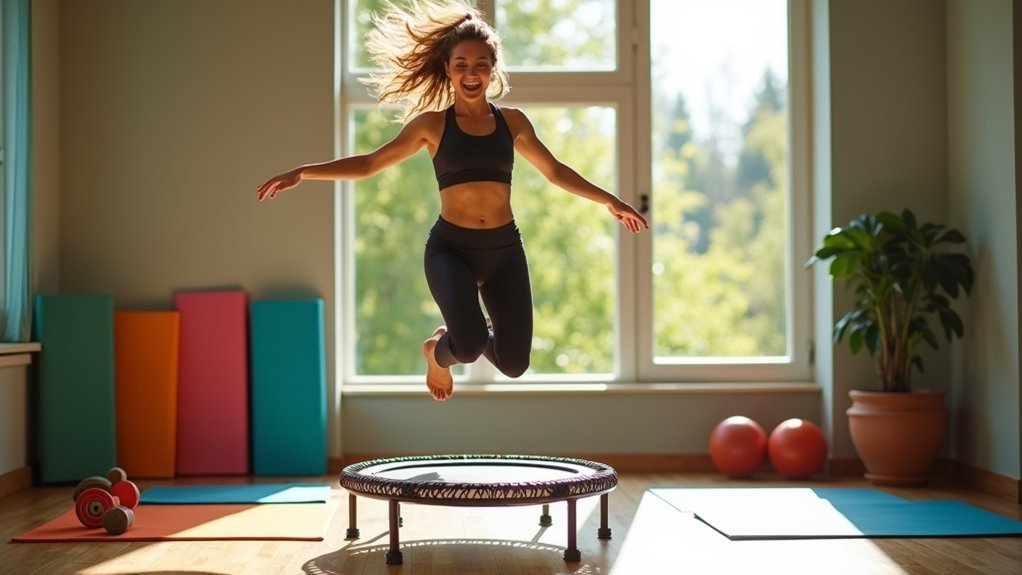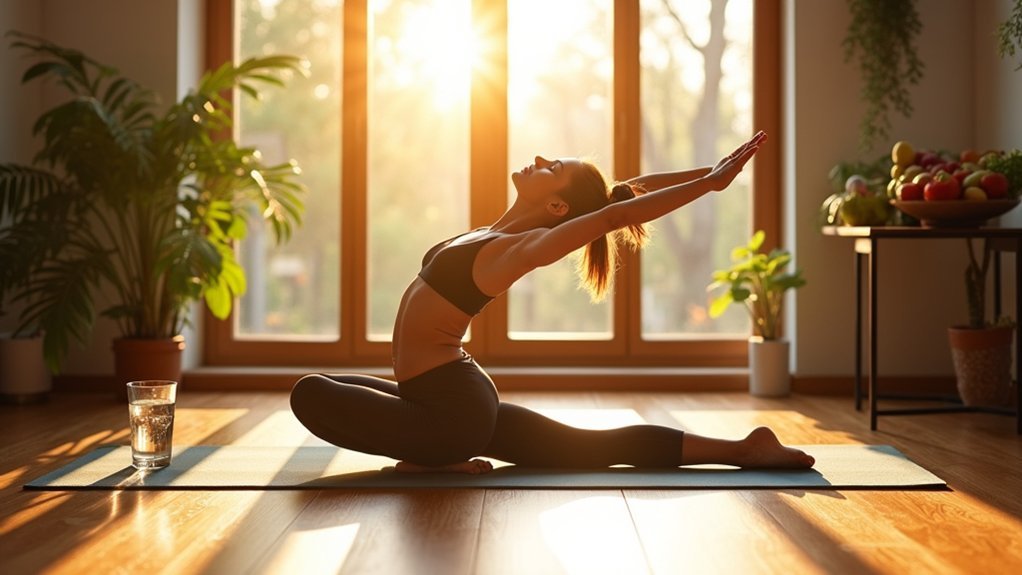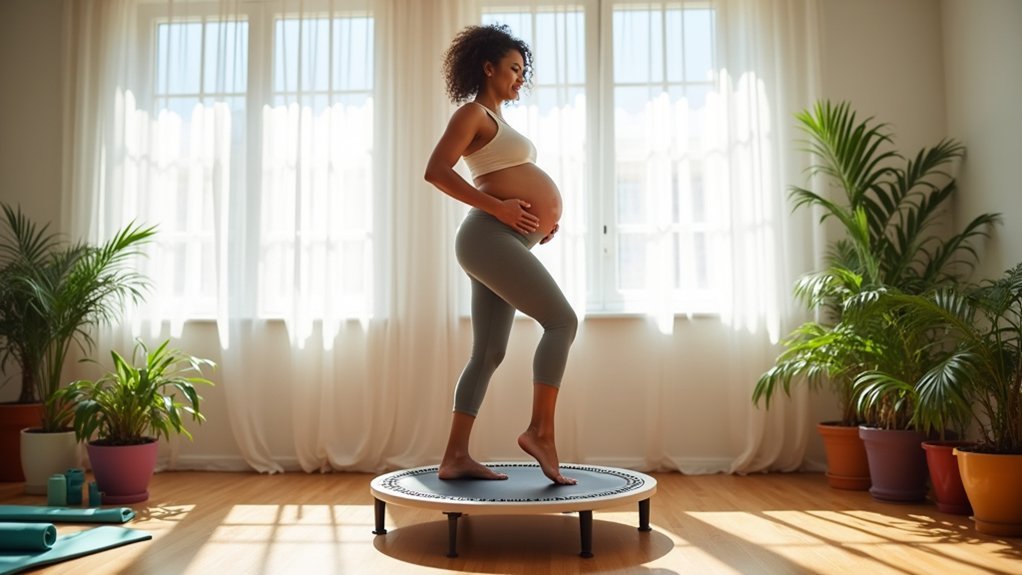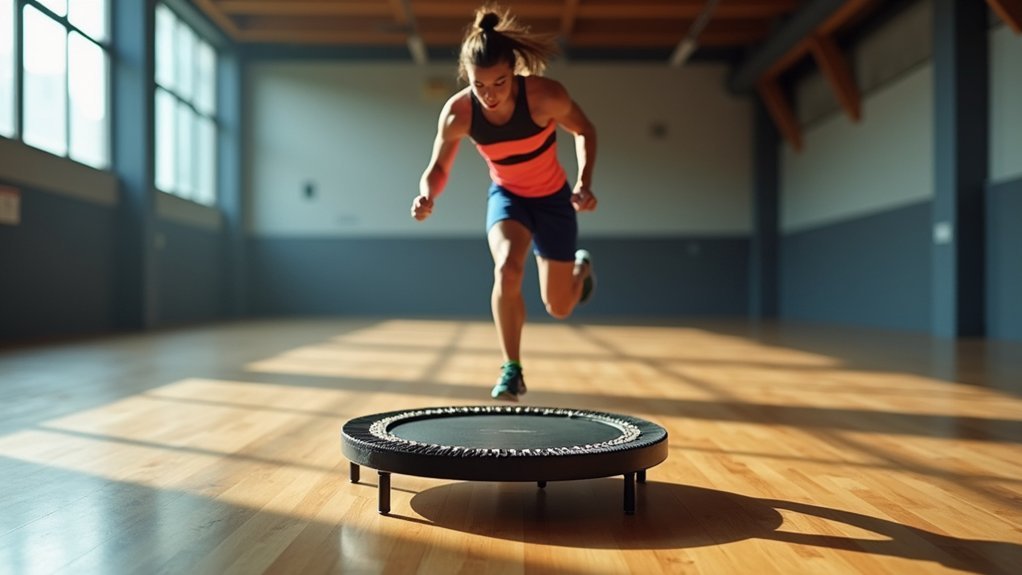Rebounding on a mini trampoline can greatly improve your bone density through mechanical loading forces. Just 50 jumps daily, 4 times weekly, stimulates bone remodeling while being gentler on joints than traditional jumping. Start with 10-minute sessions and include varied movements like jumping jacks and lateral hops. You’ll need a sturdy trampoline that absorbs impact while providing resistance. Different approaches work best at various life stages, with safety considerations becoming increasingly important as you age.
The Science Behind Rebounding and Bone Density

While researchers have long studied the effects of exercise on bone health, rebounding on mini-trampolines has recently emerged as a potential tool for improving bone density. When you bounce, the repetitive loading and unloading forces stimulate bone remodeling through mechanical strain.
Studies show promising results, particularly in postmenopausal women, with improvements in femur neck bone mineral density following rebound training. Your body responds to this unique movement pattern by increasing bone formation markers like alkaline phosphatase while reducing bone degradation indicators.
The trampoline’s elasticity reduces harsh ground reaction forces while still delivering effective skeletal stimulation. This makes rebounding particularly valuable for those with joint concerns who need bone-strengthening exercise.
However, more rigorous research is needed to conclusively isolate rebounding’s specific benefits compared to land-based exercises. Safety concerns exist for those with osteoporosis, as improper technique during rebounding has been linked to vertebral compression fractures in some patients.
Getting Started: Mini Trampoline Selection for Bone Health
Choosing the right mini trampoline marks your first critical step toward improving bone health through rebounding. Look for models with sturdy construction and a wide base to guarantee stability during your workouts.
Consider portability if you’ll need to store your trampoline between sessions. Some compact designs fold easily while maintaining durability.
Safety features like adjustable height settings and enclosures are particularly valuable if you’re new to rebounding or have balance concerns.
Check the weight capacity specifications carefully—your trampoline must safely support you throughout various exercises. The surface should absorb at least 80% of impact, protecting your joints while still providing enough resistance to benefit your bones.
Don’t compromise on capacity—proper impact absorption balances joint protection with bone-strengthening resistance.
For postmenopausal women and those with osteopenia, selecting a high-quality trampoline isn’t just about convenience—it’s an investment in your skeletal health. However, be aware that mini-trampolines pose serious risks of compression fractures for individuals with osteopenia or osteoporosis.
5-Minute Daily Bounce Routines for Maximum Bone Impact

Now that you’ve selected your ideal mini trampoline, it’s time to focus on what really matters—the specific routines that will strengthen your bones. Aim for 50 jumps daily, at least four times weekly to improve bone mineral density.
Break your bouncing into short, high-intensity intervals—10-12 minute sessions with 45 seconds of work followed by 15 seconds of recovery. Try jumping jacks, jump rope hops, hamstring curls, and lateral ski hops to diversify movement patterns and challenge bones in different planes.
For beginners or older adults, start with just 10 minutes daily and gradually increase. Remember, consistency trumps duration—regular short routines produce cumulative bone-strengthening effects.
Consider incorporating single-leg hops and balance exercises to reduce fall risk while maximizing bone benefits. While mini trampoline exercises are beneficial, they may not effectively improve lumbar spine density since jumping doesn’t generate sufficient force to stimulate lower back bones.
Rebounding vs. Traditional Jumping: Which Builds Stronger Bones?
When it comes to strengthening bones, many exercise enthusiasts face a crucial decision: should you opt for traditional jumping on hard surfaces or rebounding on a mini-trampoline?
Traditional jumping generates higher ground reaction forces that effectively stimulate bone remodeling through greater mechanical strain. This makes it superior for intensive bone building, particularly during youth.
However, rebounding offers unique advantages. The trampoline’s cushioning effect reduces joint impact while still providing beneficial repetitive loading. You’ll experience increased “gravitational force” during bounce cycles that stimulates bones differently. Studies have shown that competitive trampolinists demonstrate significantly higher bone density in both the hip and spine regions.
This gentler approach is ideal if you have joint pain, arthritis, or balance concerns.
For best results, consider your individual needs. If joint protection is priority, choose rebounding. For maximum bone density gains, traditional jumping delivers stronger osteogenic responses.
Tracking Your Progress: Measuring Bone Strength Improvements
To effectively monitor your bone-building efforts, understanding how to track progress becomes essential. While you can’t visibly see bones strengthening, several technologies can measure improvements over time.
- Bone Density Scans – DXA remains the gold standard for measuring bone mineral density, providing T-scores that track changes in your hip and spine. T-scores less than -2.5 indicate osteoporosis, while scores between -1 and -2.5 suggest osteopenia. Consider scheduling tests every 1-2 years.
- Portable Options – Between clinical visits, peripheral measurements like heel ultrasound (QUS) or wrist scans (pDXA) offer convenient tracking options without radiation exposure.
- Biochemical Markers – Blood or urine tests can detect changes in bone turnover before they appear on density scans, giving you earlier feedback on whether your rebounding routine is working.
Combining Rebounding With Nutrition for Optimal Bone Growth
The powerful synergy between rebounding exercise and proper nutrition creates the ideal environment for bone growth and maintenance.
While rebounding alone may not notably increase bone density, pairing it with calcium and vitamin D-rich foods amplifies your results.
Focus on incorporating Mediterranean diet elements like fatty fish (high in omega-3s) and calcium-fortified foods to prevent bone loss.
Don’t forget protein sources such as poultry and fish, which are essential for bone development.
For maximum benefit, time your nutrition around your rebounding sessions.
Consider calcium supplements if your dietary intake falls short, but always consult healthcare professionals for personalized advice.
The combination of regular rebounding and strategic nutrition will strengthen not just your bones but supporting muscles too, creating extensive skeletal health improvements.
Recent research shows that avoiding ultra-processed foods with their low nutritional value is crucial for proper bone development during growth periods.
Adapting Your Routine: Age-Specific Rebounding for Lifelong Bone Health
Rebounding exercises must be tailored to your age and physical condition to maximize bone health benefits throughout life. Your skeletal needs evolve dramatically from childhood to your senior years, requiring specific approaches to bouncing for ideal results.
Customize your rebounding routine to match your life stage for optimal skeletal strength and protection.
- Early years (childhood to 40s): Focus on higher-impact bouncing and varied movements to build and maintain peak bone density. Include jumping jacks and jogging in place to stimulate maximum bone growth.
- Middle age (40s-60s): Incorporate moderate bouncing with balance exercises to combat declining bone density while protecting joints from unnecessary stress.
- Senior years (60+): Prioritize gentle, controlled bouncing with handrail support to improve balance, reduce fall risk, and maintain functional mobility without compromising safety. This gentle approach delivers lymphatic drainage benefits while minimizing potential injury risks for those with more fragile bones.
Frequently Asked Questions
Can Rebounding Help Reverse Existing Bone Loss or Osteoporosis?
While rebounding can improve balance and muscle strength, there’s insufficient evidence it reverses bone loss. You’d benefit more from combining it with proven bone-building exercises like weight-bearing activities and resistance training.
Is Rebounding Safe for People With Joint Problems?
Yes, rebounding is generally safe for joint problems as it’s low-impact. You’ll need to start slowly, use proper technique with bent knees, and choose a quality rebounder. Consult your doctor first though.
How Long Before I See Measurable Improvements in Bone Density?
You’ll likely see measurable improvements in bone density after 6 months of consistent exercise. Your age matters – younger bodies respond faster, while those over 50 may need longer to see significant changes.
Should I Wear Special Shoes When Rebounding for Bone Health?
Regular athletic shoes with good grip are usually sufficient for rebounding. You don’t need special shoes, but they may enhance comfort and stability. Focus more on consistent exercise than specialized footwear for bone health benefits.
Can Rebounding Replace Calcium and Vitamin D Supplements?
No, you can’t replace calcium and vitamin D supplements with rebounding alone. While rebounding stimulates bone growth, your body still needs these essential nutrients to build and maintain bone strength. Use both for best results.
In Summary
You’ve now discovered how rebounding can transform your bone health. By jumping just minutes daily, you’re stimulating bone growth while protecting your joints. Remember, consistency trumps intensity—bounce regularly, fuel properly, and adjust your routine as you age. Track your progress and celebrate improvements. Whether you’re preventing bone loss or building density, your mini-trampoline might become your skeleton’s best friend. Keep bouncing for stronger bones!





Leave a Reply